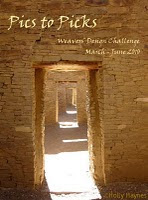There were twelve of us at the workshop so we took turns at the dye vat, making sure that we did not get too much air into the vat while agitating the bundles of fabric. I don't think we did that very well as the indigo dye did not survive well into the second day. Yoshiko and Colleen Weste revived it and we tried to be more careful.
While we took our turns at the dye vat, Yoshiko demonstrated the capping techniques using some special tools.
There was a 2-dollar shop downstairs and some of the others wrapped their fabric around strings of plastic beads. It was a simple and quick technique but very effective. Yoshiko was encouraging minimum effort, maximum results! I can't agree more.
We wrapped the fabric around the PVC pipe, tied with string and pushed each section up as tightly as possible. In the midst of all the action, it was actually quite difficult to keep up with taking photographs.
Another technique we touched on was using the sewing machine to help create the paths of resist. We laid layers of calico over the fabric. In this case, a bit of cotton/silk off cut that I found in my fabric stash. (I knew there was a reason I don't throw them away!)
I really liked this technique as it was quick and easy. The quick-unpick tool came in handy. It is like a combination of fold/clamp and stitching but gives quite clear, defined shapes.



















.jpg)